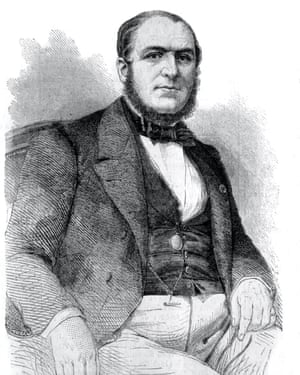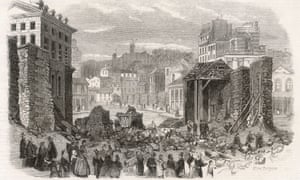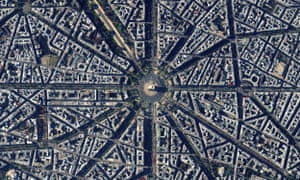
He was the Parisian who ripped up his home city; one of the most famous and controversial urban planners in history. Even now, 125 years after the death of Baron Georges-Eugène Haussmann, France remains divided over whether the man who transformed Paris into the City of Light was truly a master planner – or an imperialist megalomaniac.
Internationally, Haussmann is celebrated for much that is loved about the French capital; notably those wide avenues flanked with imposing buildings of neatly dressed ashlar and intricate wrought iron balconies.
To his republican compatriots, however, Haussmann was an arrogant, autocratic vandal who ripped the historic heart out of Paris, driving his boulevards through the city’s slums to help the French army crush popular uprisings.
Historian and Haussmann expert Patrice de Moncan is exasperated by the century’s worth of criticism that has been levelled at this hugely influential figure. “Sometimes I don’t know where to start; it’s bullshit from beginning to end,” De Moncan says. “But it’s a view many people still hold in France.

“Haussmann has been portrayed as this almost sinister figure, only out to enrich himself and with his fingers in the till. His critics accused him of filling Paris with cobbled streets, bland buildings with stone facades, and wide, dead straight avenues so the army could repress the masses.”
De Moncan, who is writing a new biography of Haussmann, smarts with the injustice of what he sees as the ongoing maligning of his hero. “Some said he was austere, but from what I have discovered he liked a good party and threw great ones. Others accused him of chasing the girls – it’s true he had a mistress [the opera star Francine Cellier] with whom he had a child, but unlike others at that time, he accepted, recognised and educated the girl.”
In 1848, Haussmann was an ambitious civil servant determinedly climbing the ranks when Louis-Napoléon Bonaparte – nephew and heir of Napoléon I – returned to Paris after 12 years’ exile in London to become president of the French Second Republic.
Bonaparte, later elected Emperor Napoléon III, hated what he saw. In his absence, the population of Paris had exploded from 759,000 in 1831 to more than a million in 1846 – despite regular outbreaks of cholera and typhoid that killed tens of thousands.
The French capital was overcrowded, dingy, dirty and riddled with disease. Why, Bonaparte pondered, was it not more like London, with its grand parks and gardens, its tree-lined avenues and modern sewage system? Paris, he declared, needed light, air, clean water and good sanitation.

Haussmann was an imposing figure both physically – at 6ft 3in – and intellectually. Born into a bourgeois military family with strong Lutheran ties, he had been a brilliant student at elite Paris colleges, and personified the Protestant work ethic. Portraits show a tall, solid, often studious figure with a not unkind face, often sporting a chin-strap beard and, in later years, thinning hair.
France’s interior minister, Victor de Persigny, believed Haussmann to be the ideal candidate for the job of Prefect of the Seine and overseer of Napoléon III’s plan to transform the city. “He is one of the most extraordinary men of our time; big, strong, vigorous, energetic and at the same time clever and devious,” wrote De Persigny to the emperor. “He told me all of his accomplishments during his administrative career, leaving out nothing: he could have talked for six hours without a break, since it was his favourite subject, himself.”
Haussmann got the job. A week after his appointment in the summer of 1853, he was summoned to the emperor’s official residence at the Palais des Tuileries, where Napoléon III produced his plan for Paris. It showed a map of the city with three straight, dark lines drawn over it: one running north-to-south and two east-to-west either side of the Seine, all cutting through some of the most densely populated but historic areas of central Paris.
“This is what I want,” Napoléon III told Haussmann. It was the start of the most extensive public works programme ever voluntarily carried out in a European city, turning Paris into a vast building site for more than 17 years.
Haussmann cut a swathe through the cramped and chaotic labyrinth of slum streets in the city centre, knocked down 12,000 buildings, cleared space for the Palais Garnier, home of the Opéra National de Paris, and Les Halles marketplace, and linked the new train terminals with his long, wide and straight avenues.
Less well known is Haussmann’s commissioning of an outstanding collection of street furniture – lampposts, newspaper kiosks, railings – and the decorative bandstands in the 27 parks and squares he created.
Below ground, Haussmann oversaw the installation of les egouts, the city’s complex sewage network. He also commissioned reservoirs and aquaducts to bring clean drinking water to the city.
On his orders, gas lamps were installed along the widened cobbled streets; now when the elegant flâneurs who strolled the 137km of new boulevards retired for the night, the revellers and prostitutes who emerged from the bars and the shadows could walk safely. The new streets came with trees and broad pavements along which café terraces sprang up, soon to be filled with artists and artisans enjoying “absinthe hour”.

In his Dictionary of the Second Empire, Josephy Valynseele wrote of Haussmann: “During his career he showed a maniacal ambition, an impudent opportunism and was, whatever he did, a genius of showmanship.”
But republican opponents criticised the brutality of the work. They saw his avenues as imperialist tools to neuter fermenting civil unrest in working-class areas, allowing troops to be rapidly deployed to quell revolt. Haussmann was also accused of social engineering by destroying the economically mixed areas where rich and poor rubbed shoulders, instead creating distinct wealthy and “popular” arrondissements.
Critics also accused him of destroying the city’s medieval treasures, citing the enduring charm of the narrow winding streets of the Marais: the city’s oldest district and one which escaped Haussmann’s razing.
There was additional outrage at the staggering 2.5bn franc bill for the work – around €75bn today. By 1869 the attacks had become deafening, and Haussmann was forced to vigorously defend himself before MPs and city officials. In the hope of salvaging his own flagging popularity, Napoléon III asked Hassmann to resign. He refused.
“Haussmann had a great belief in public service and had spent his whole career in the service of the king and then the emperor,” De Moncan says. “He believed if he resigned it would be assumed he had done wrong, when in fact he was very proud of what he had done. Napoléon III offered him all manner of inducements but he still refused, so the emperor sacked him.
“The Second Empire and Napoléon III were despised by republicans, and Haussmann was the victim of this political backlash. Victor Hugo hated him, and because everyone in France regarded what Hugo wrote as the word of God, they hated Haussmann too. Hugo, the man who wrote Les Miserables about how desperate conditions were in Paris, accused Haussmann of destroying the city’s medieval charm!”

De Moncan observes this was the same “charm” that had brought epidemics to Paris; the charm that “had 20 people living in one room with no light and no toilets, just a common courtyard into which they did their business. People like Hugo forgot how truly miserable Paris had been for ordinary Parisians.”
Out of a job and persona non grata in Paris, Haussmann spent six months in Italy to lift his spirits. He returned and was given a management post with the military – which lasted less than a week before Napoléon III was defeated.
Haussmann lived out his final days in rented accommodation on a paltry 6,000-franc pension, the equivalent of €20,000 a year today, paying regular visits to his three beloved daughters. In his memoirs, he seems stoic rather than bitter about his fall from grace:
“In the eyes of the Parisians, who like routine in things but are changeable when it comes to people, I committed two great wrongs. Over the course of 17 years I disturbed their daily routines by turning Paris upside down; and they had to look at the same face of the prefect in the Hôtel de Ville. These were two unforgivable complaints.”
Some of Haussmann’s harshest critics, including the politician and philosopher Jules Simon, later changed their view of him: “He tried to make Paris a magnificent city and he succeeded completely,” Simon wrote in 1882. “He introduced into his beautiful capital trees and flowers, and populated it with statues.”
Today, Haussmann is remembered by the grand boulevard that bears his name, on which the Palais Garnier sits, and a statue on its corner with Rue de Laborde in the 8th Arrondissement. But according to De Moncan, Haussmann’s vital contribution to modern Paris is still not fully appreciated.
“Haussmann was never forgiven or recognised in his lifetime in France, and still isn’t. If I give a conference here, people groan when I talk about him. Right up until the 1980s, his buildings were dismissed as rubbish and as many as possible were destroyed, so that all those unlovely 1970s glass and concrete structures could go up.
“But what he did was phenomenal; he was the world’s first modern urban developer. Everyone who came to Paris for the universal exhibitions, including Queen Victoria, was astonished by the transformation of the city. In 1867, there was a meeting of European architects in Germany at which Haussmann was hailed as a pure genius; a brilliant modern urban developer. Yet all that was said about him back home was that he was a crook.”
Does your city have a little-known story that made a major impact on its development? Please share it in the comments below or on Twitter using #storyofcities